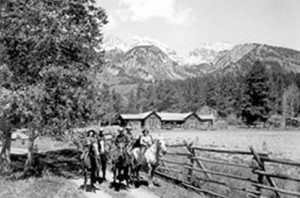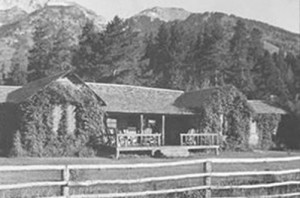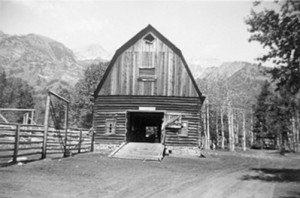Following Frank Galey’s death in July 1985, many changes came to the ranch in quick succession. Dude ranch operations concluded at the end of the season in 1985. There was a large auction at the ranch in September 14-15. On Saturday, November 2, 1985, the cabin Frank Galey built in the late 1940s with his wife, Inge, burned to the ground. His second wife, Nona was living in the home at the time of the fire.
In the second half of 1985, the Grand Teton National Park, owner of the White Grass Ranch since 1956, began an inventory of the property which included aerial photography. Shortly thereafter, the Park began efforts to return the land to its ‘natural state’ removing many White Grass buildings not on the National Register of Historic Places and several landscape features.
In 2002, the Park began to explore the feasibility of rehabilitating the ranch for a National Park Service training center to teach historic preservation skills. That process began with a condition assessment of the 13 original and historic log structures, most of which were constructed before 1935. Results were encouraging that the buildings could be rehabilitated. From 2006-2016, crews worked to rehabilitate ranch buildings for a preservation training center. Training workshops began in 2014.
The Life & Death of Frank Galey
Frank Galey died of an apparent heart attack at the ranch July 6, 1985 at the age of 68 (1917-1985). He first visited the ranch when he was a toddler with his mother (a widow) and three sisters. In 1936, his mother married Harold Hammond, one of the original homesteaders of White Grass Ranch. Upon Hammond’s death in 1939, Galey returned to help his mother run the ranch and eventually took ownership. Though Galey sold the ranch to the Grand Teton National Park in 1956, he held a lifetime lease to run the ranch until his death. His passing and the closing of the ranch was mourned deeply by many.
Curt Windsor wrote about Galey, “I think I spent 12 summers at White Grass and they are among the happiest of my life, thanks to him (Galey). The Ranch was his and it mirrored his personality – warm, friendly, informal, relaxed, a little inefficient but always enjoyable . . . Frank could do anything and really do it well – build, handle horses, handle people, fish, shoot, play cards – you name it. He was a universal man.” Curt Windsor, Philadelphia, July 10,1985.
Click here to read his obituary.
The Ranch Auction & Fire
After Galey’s death, his second wife, Nona, held an auction at the ranch September 14-15, 1985. The auctioneer estimated that over 1,500 attended with over 750 registered bidders from 15 states. Sold at auction were 85 horses and some cattle, farm equipment, cabin furnishings, over 70 saddles and tack, and kitchen equipment. The lodge pole pine furniture, antique firearms and fireplace iron screens adorned with cowboy or big game scenes brought high prices. Some items bought at auction in 1985 have been gifted back to White Grass where many are on display. Click here to see the newspaper articles. Click here to see some of the items that have been returned to the Ranch.
On Saturday, November 2, 1985, the cabin Frank Galey built in the late 1940s with first his wife, Inge, burned to the ground. His second wife, Nona, was living in the home at the time of the fire. Lost in the fire were decades of ranch records and photographs in addition to cabin furnishings. Many art and cultural objects of significance once displayed throughout the cabin were also not found after the fire. Shortly thereafter, Nona left the ranch never to live on the property again. Click here to read more about the White Grass fire in the news.
The Park Inventory
In the later half of 1985, the Grand Teton National Park, began to inventory the ranch property, buildings and landscape features. The inventory included several aerial photographs.
Returning White Grass to a Natural Park
After taking possession of the ranch in 1985, Park Superintendent Jack Stark made clear his intent to remove any items that he legally could and to return the ranch property to the “natural part of the Park.” Soon thereafter, a bulldozer was dispatched to remove many landscape features, e.g., the swimming pool, the lake, irrigation ditches, entrance archways, fences and some roads. Buildings were removed and sold except for 13 original log structures that were protected as they were on the National Register of Historic Places. The Park also removed many truckloads of debris and discarded vehicles. To learn more about the Park’s role, click here to view “Al Williams: Cultural Resources and Ranch Rehabilitation” video.
An Assessment: Condition of the Ranch
After ranch closure, former dudes and wranglers, local and state officials, preservationists, volunteers and community leaders pressed the Park to maintain the buildings and reopen it as a dude ranch or use it for another purpose. Allowing the buildings to fall to the ground due to disrepair and neglect was, in their minds, not an option, not acceptable.
Under the leadership of new Park Superintendent Steve Martin (2002-2003), the Park began to value both the natural part of the Park and its cultural resources. In 2002, a condition assessment was done by Harrison Goodall, architectural conservator, evaluating the feasibility of rehabilitating the buildings at White Grass for use as a training center to teach preservation skills. That assessment looked at issues related to: (1) the natural decline of log structures built 50-60 years prior to ranch closure and (2) the absence of maintenance given ranch buildings from 1985-2002. He evaluated the integrity of the foundations, logs and log joints, roofs and their understructure, windows and doors, chimneys and landscape issues including water drainage and vegetation. Despite documented problems, Goodall concluded, “White Grass buildings were sound but needed immediate preservation and use.” Click here to see the condition assessment slideshow by Goodall.




